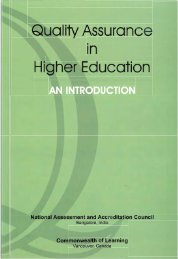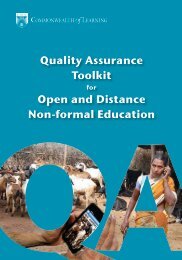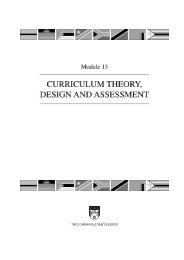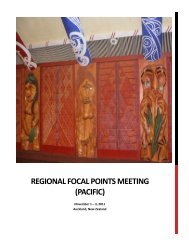Tech-MODE for Agricultural Education and Improved Livelihoods in ...
Tech-MODE for Agricultural Education and Improved Livelihoods in ...
Tech-MODE for Agricultural Education and Improved Livelihoods in ...
Create successful ePaper yourself
Turn your PDF publications into a flip-book with our unique Google optimized e-Paper software.
STAKES AND CHALLENGES FOR TECH-<strong>MODE</strong> IN AGRICULTURAL EDUCATION IN CAMEROON<br />
be harnessed to embrace these obstacles <strong>and</strong> trans<strong>for</strong>m them <strong>in</strong>to challenges <strong>and</strong><br />
opportunities <strong>for</strong> susta<strong>in</strong>able development <strong>in</strong> Africa <strong>in</strong> the 21st Century.<br />
Pr<strong>in</strong>cipal acronyms<br />
COL Commonwealth of Learn<strong>in</strong>g<br />
GCE AL/OL General Certificate of <strong>Education</strong> Advanced Level / Ord<strong>in</strong>ary Level<br />
ICT(s) In<strong>for</strong>mation <strong>and</strong> Communication <strong>Tech</strong>nology(ies)<br />
NGO Non-Governmental Organisation<br />
ODL Open <strong>and</strong> Distance Learn<strong>in</strong>g<br />
R&D Research <strong>and</strong> Development<br />
S&T Science <strong>and</strong> <strong>Tech</strong>nology<br />
<strong>Tech</strong>-<strong>MODE</strong> <strong>Tech</strong>nology-Mediated Open <strong>and</strong> Distance <strong>Education</strong><br />
UD University of Dschang, Cameroon<br />
UoG University of Guelph, Canada<br />
1 Introduction<br />
Africa offers many opportunities. Firstly, it is richly endowed with natural resources.<br />
Secondly, the cont<strong>in</strong>ent abounds with unmatched diversity <strong>and</strong> richness of economic<br />
potentials <strong>for</strong> effective development. Thirdly, the geographical size of the cont<strong>in</strong>ent<br />
is a development asset that needs to be exploited. F<strong>in</strong>ally, its colonial history – an<br />
erstwhile obstacle which could be trans<strong>for</strong>med <strong>in</strong>to an opportunity <strong>in</strong> today’s<br />
globaliz<strong>in</strong>g world.<br />
The fact that the African cont<strong>in</strong>ent was <strong>in</strong>vaded, exploited <strong>and</strong> later ab<strong>and</strong>oned by<br />
colonialists can be trans<strong>for</strong>med <strong>in</strong>to an opportunity today. Exposure <strong>and</strong> relations<br />
with the world’s major civilizations, such as English, French, Portuguese <strong>and</strong> German<br />
ought to be seen as an opportunity today <strong>for</strong> easier, friendlier, collaborative <strong>and</strong><br />
cooperative dialogue <strong>for</strong> social, economic <strong>and</strong> political trans<strong>for</strong>mations <strong>in</strong> Africa.<br />
Notwithst<strong>and</strong><strong>in</strong>g these opportunities, Africa rema<strong>in</strong>s the most “backward”, <strong>and</strong><br />
“hopeless” of all the cont<strong>in</strong>ents <strong>in</strong> the world. It has also been referred to as the<br />
“dark”, “<strong>for</strong>gotten” cont<strong>in</strong>ent. These negative labels have been imposed by a<br />
conspiracy of circumstances that characterize perpetual underdevelopment of the<br />
region: ethnic conflicts <strong>and</strong> wars with<strong>in</strong> <strong>and</strong> outside national boundaries, a yawn<strong>in</strong>g<br />
chasm of illiteracy, high <strong>and</strong> stubborn disease prevalence <strong>and</strong> low levels of<br />
development <strong>and</strong> application of science <strong>and</strong> technology (Nji, 2004).<br />
All these factors negate the development of Africa’s key <strong>in</strong>dustry, agriculture, which<br />
is considered to be the eng<strong>in</strong>e or the lever of development <strong>for</strong> all the nations of the<br />
world.<br />
TECH-<strong>MODE</strong> FOR AGRICULTURAL EDUCATION AND IMPROVED LIVELIHOODS IN SUB-SAHARAN AFRICA: COUNTRY CASE STUDIES ■ 27









